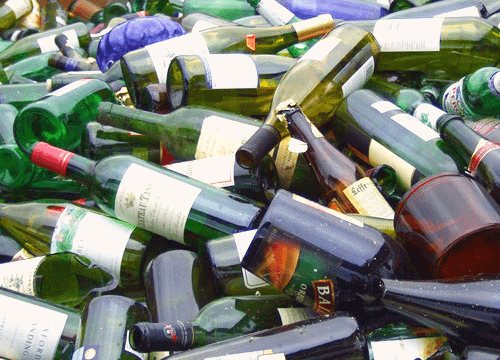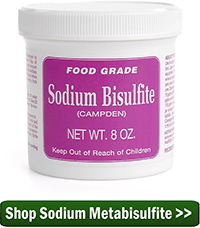 I’m just starting in wine making and my first batch, one gallon of strawberry wine is about ready to be bottled. I have wine bottles from a local hotel/convention center. A friend told me to get Iodophor to sterilize them, but I’m not sure what that is. Can you tell me what I should do to clean these bottles?
I’m just starting in wine making and my first batch, one gallon of strawberry wine is about ready to be bottled. I have wine bottles from a local hotel/convention center. A friend told me to get Iodophor to sterilize them, but I’m not sure what that is. Can you tell me what I should do to clean these bottles?
Thank You
Jerry R.
——–
Hello Jerry,
Whether you need to clean 5 or 6 wine bottles or 50 or 60 bottles, the process of cleaning and sanitizing the used wine bottles is the same.
Getting the labels off the used wine bottles will be the first job at hand. I have found that there are two types of glues used to put labels on wine bottles: the kind that allows the labels to fall off with a little soaking in water, and the kind that requires a lot of scrubbing, regardless of how long you soak them.
Since you only need five or six bottles, I would take a dozen or so at random. Put them in a soapy bath. You can use a plastic fermenter or something similar. Let them sit over night, and see which labels fall off. Hopefully, you’ll have at least five. If none of the labels fall off the used wine bottles, this will reduce you to having to scrape them of with a utility razor.
Once you get the wine bottle labels off you will need to get the used wine bottles soapy clean, both inside and out. Cleaning the used wine bottles means all the grit and grime needs to be removed.
Regular dish soap works fine for this purpose. You will need a wine bottle brush to scrub the inside and get any dried, leftover wine removed. Our Brass Bottle Washer is also handy for blasting out the inside of the wine bottle with water. It also makes rinsing the soap from the inside of the bottle much easier and quicker.
 Now the used wine bottles are clean, but clean isn’t good enough for bottling wine. They need to sanitized. Your friend’s idea of using Iodophor is not a bad idea and will work for this process, however most winemakers prefer to use sodium metabisulfite for sanitizing their used wine bottles.
Now the used wine bottles are clean, but clean isn’t good enough for bottling wine. They need to sanitized. Your friend’s idea of using Iodophor is not a bad idea and will work for this process, however most winemakers prefer to use sodium metabisulfite for sanitizing their used wine bottles.
There should be directions that come with the sodium metabisulfite, but essentially all you do is mix in 1 teaspoon for each gallon of water. You don’t want to put the wine bottles in the solution, but rather, just put an inch or two of the solution in each wine bottle and let them stand for 20 or 30 minutes. The sulfur fumes from the sodium metabisulfite will sanitize the insides without any effort on your part.
Cleaning and sanitizing used wine bottles can seem like a chore the first time you do it, but what I and most others have eventually discovered is that once you have your own system down, its really not that difficult.
I hope this helps you out.
Best Wishes,
Ed Kraus
———————————–
Ed Kraus is a 3rd generation home brewer/winemaker and has been an owner of E. C. Kraus since 1999. He has been helping individuals make better wine and beer for over 25 years.

when is the best time to clean and sanitize the used wine bottles?
Robert, you should clean them as soon as you get them. You should sanitize them right before using them.
I have done hundreds of used bottles,I bought them from winery’s by the case,some times 10 t 0 15 case;s,first scrape them with a razor scraper,soak in warm water,and then add bisulfate to the water or a no sud’s cleaner,Take a bottle brush,cut the top.(the hook or loop),and I used an electric (battery type) drill and drill cleaned the bottles,save’s a lot of time.when dried I sanitized and stored up side down in the case they came in,with clean paper towel’s on the bottom of the box.
Using the bottle brush with a drill is a great idea.
Another good gadget for last minute bottle sterilization is your plastic resourvoir with pump which squirts your cleaning solution up into the bottle. Maybe you can clarify my description with a picture.
I have been cleaning and sterilizing with a plain bleach and dish washing liquid, and rinsing well. Is this an ok process? The smaller bottles I put in the dish washer.
Tony, you can sanitize your bottles with unscented bleach. We recommend 1/4 cup per gallon of water. It is very effective. The real issue is that it does not easily rinse. So as you have mentioned, you need to excessively rinse the bottles.
Have been cleaning used bottles for 15 years. My insulated cooler holds 24 to 30 bottles. I fill each bottle with hot soapy water and also fill the cooler and close the lid. The heat on the inside and outside of the bottle softens the adhesive. Within 1/2 hr many of the labels can be pulled off or easly razored off. The tough ones take additional soaking but also razor off easily.
I can complete two batches of delabeling with the same water. One observation I found. The more expensive wine labels are tougher to remove. Cheap wine labels fall dead in quickly.
The problem with using a razor or other rigid blade for removing labels is that it takes a lot of strokes due to the bottle curvature. I use an old credit card. It has a sharp enough edge to cut the wet label and it curves to the bottle. Many less strokes are required.
I’ve been cleaning my used wine bottle in the dishwasher using the sanitize, hot water and heat dry options. This works extremely well and cleans them until it’s time to sanitize them. Then using a pump style bottle sanitizer I mix my solution, sanitize, let stand for a few minutes and start filling. I’ve never had any problems. I hope this helps some people.
many labels that don’t come off with water respond very well to heat from a hair dryer. Use a blade to get a corner started and an oven mitt to hold the bottle. Use a (longer the better) needle nose pliers to gently grip the label corner and SLOWLY pull the label away. Concentrate the hair dryer flow near where the label is pealing away from the bottle. Use mechanics hand cleaner (I use Go-Jo Orange) to remove any glue residue. the mild abrasive and solvents in the cleaner do a great job.
I usually try this first since a water bath can weaken the label.
PS intact labels make a nice wallpaper for your winery.
Getting the labels off can become a tedious job. I soak them as you suggested, then if they do not drop off or if they can be scraped(I use a knife) to get the label and as much of the glue off as possible, let them dry, and use lacquer thinner on a rough rag to get the rest of the glue off. Any bottles that contain any type of residue on the inside, I throw away. I clean all my bottles in a dishwasher. I set the dishwasher on hard wash and wash about 30 bottles at a time (depends on size of dishwasher). This seems to do an excellent job and the bottles come out clean.
Rather than regular dish soap I use dishwasher soap. It doesn’t make suds. After soaking for a day i peel the labels off with a razor blade scraper. Then use a green ( brillo ) sanding pad . Any residual glue left on the bottle I use Goof Off on a paper towel.
For those stubborn labels that don’t soak off, I have put them is the freezer, till real cold, then scape off with a razor blade scraper. It takes the sticky residue and all. Hope this helps.
After soaking and then scraping the paper labels off with a razor scraper, I use Gojo hand cleaner or non-flammable, low odor, low VOC paint thinner that can be bought at any home improvement store to remove the residual glue. I just dip a corner of a rag into the solvent and coat the glue. It melts it in short order, and I wipe off the residue with a dry rag. Of course I rewash the bottle in a separate dish soap solution and since these solvents are water soluble, they wash off with soapy water quite easily, with no odor or trace of glue or solvent.
i’ve been delabeling wine bottles over 3 years now, I’m a auto tech that tryed all kinds of stuff to get the labels off, And so i have found the wright thing is to put the wine bottles in the realy hot water inside and out in a sink or a bathtube, put some soap i used dish soap and OXI Clean, scrap the labels then the glue that is left on the bottles i found the BRILLO pads work so good, I have told frinds thay have thank me, hand down it’s the best. A case of bottles in baout 15. cost is about 4 bucks at Walmart for the Brillo pads. You might used 2 pads on 12 bottles but most of the time just one.
Hi everyone. In my experience it is easier to just stick with bottles you know have easy peel labels. I don’ t bother with the tough ones anymore.
From 1973 to 2003, I have been making homemade wines. I don’t use special cleaners or put them in dishwater w/bleach to soak. I use the light dark-colored whiskey/wine bottles. I place room temp. water in each bottle; then I dumb out that water and fill it with hot water from the faucet. I fill the sink with the hottest water that I have of the faucet and at the same time I la each of the bottles on their sides. Continue to fill the sink of bottles till the hot water just barely covers the bottles. I usually wait for 1 to 2 hours before I start to clean off the labels. Then again I use an pan -scrubber and Brillo pad.
After all the labels are scrubbed-off and the bottles are to warm for be filled with wine. I place them on a draining rack for the cooling down time.
I always used the light and dark colored bottles, rather they are whiskey or wine bottles Plus with bottles with a twist-on cap. But for unknown reason that you have only clear bottles and you fill it with a grape wine. Exposing this bottle of wine to any light will cause to change to a grape-flavored to a raisin wine.